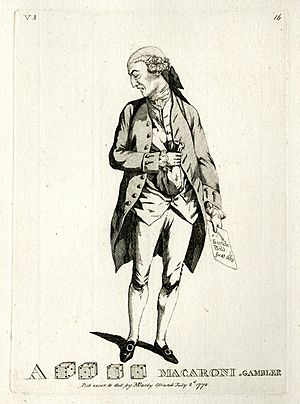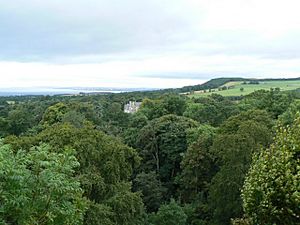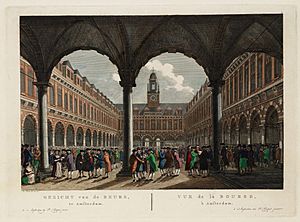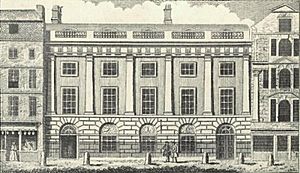Alexander Fordyce facts for kids
Alexander Fordyce (born August 7, 1729 – died September 8, 1789) was a well-known Scottish banker. He was involved in a major financial problem in 1772, when many people rushed to take their money out of his bank, Neale, James, Fordyce and Down. This event led to a big financial crisis. He had to leave the country and was declared unable to pay his debts. However, he later used money from other successful investments to pay back what he owed.
Contents
Early Life and Education
Alexander Fordyce was born in Belhelvie, Scotland. He was the youngest son of George Fordyce, who was the leader of Aberdeen six times (called a Provost). Alexander had several half-siblings, including David, Agnes, James, and William.
In 1746, he traveled around the Scottish Highlands. His uncle, Thomas Blackwell, who taught law at Marischal College, helped educate him. Later, his uncle also became his brother-in-law. For a while, Alexander worked in the hosiery (sock and stocking) business in Aberdeen.
In 1757, he moved to London. He found a job as a clerk for a bank called Boldero & Co. on Lombard Street, London, which was a famous banking area. His brother James joined him in London in 1759 and became a minister.
Entering Politics and Marriage
In 1768, Alexander tried to become a Member of Parliament for Colchester. He spent a lot of money, nearly £14,000, on his campaign. However, he lost the election by 43 votes to Charles Gray.
In June 1770, when he was 42, Alexander married Lady Margaret Lindsay. She was 17 years old and the daughter of James Lindsay, the Earl of Balcarres. They were married at Balcarres House in Fife. In the same year, Alexander was also chosen as the rector (a leader) of Marischal College, Aberdeen.
Alexander Fordyce: Banker and Investor

Starting in 1757, Alexander Fordyce became a partner in the banking firm Neale, James, Fordyce and Down. Their bank was located on Threadneedle Street in London. Alexander was very good at making smart investments. He gained a lot of money in 1763 by getting early news about the signing of the Peace of Paris, which ended a war.
In 1764, Fordyce worked with another banking firm, Hope & Co., from Amsterdam. The shares of the East India Company (a powerful trading company) increased a lot in value between 1764 and 1765. With the money he made from these and other investments, Fordyce bought a large estate near Wimbledon. He lived a very grand life there, hosting many parties and events.
In July 1770, Fordyce borrowed a large sum of money, 240,000 guilders, from Hope & Co. This money was for a project with two planters from Grenada. He also worked with other important people like Sir William Pulteney and Samuel Hannay. Fordyce was making successful investments and managed to hide some of his activities from his partners for a while. It's said he once showed them a pile of borrowed banknotes to make them feel better about the bank's money.
However, his luck changed. In early 1771, he lost a lot of money because of changes in the market. This happened during a disagreement with Spain over the Falkland Islands. In 1771 and 1772, Fordyce made a very big bet against the price of East India Company shares, which went terribly wrong. In May 1772, the price of these shares actually went up a lot.
The Financial Crash of 1772
On Monday, June 8, 1772, it became clear that Alexander Fordyce was in serious financial trouble. The next day, he disappeared to avoid paying his debts. His bank stopped allowing people to withdraw money on June 10. Fordyce then left for France. He had lost a huge amount of money, £300,000, by betting against East India Company shares. This left his partners responsible for about £243,000 in debts. He had used the bank's money for his investments and lost the support of the Bank of England. On June 13, an advertisement was put out, asking him to return and reveal all his belongings and money.
The news of his bank's failure reached Scotland on June 12. After the weekend, people in Edinburgh rushed to withdraw their money from the bank's branch there. Within two weeks, eight banks in London also closed down. On June 24, 1772, Fordyce's belongings, investments, and country house were taken by the government. The whole City of London was in chaos when Fordyce was officially declared unable to pay his debts. His bank, Neale, James, Fordyce and Down, which was a major buyer of Scottish financial papers, had to declare that it could not pay its debts. Another bank in Ayr, Scotland, also collapsed on June 24.
This bank failure caused a big financial crisis. Other important bankers, like Sir Richard Glyn and Sir Thomas Hallifax, temporarily stopped payments. Sir George Colebrooke also came close to stopping payments. On July 25, Fordyce was given seven weeks to meet his creditors (the people he owed money to) and try to reach an agreement. About 20 banks across Scotland and the Netherlands also failed because of this crisis.
Fordyce was brought back from France and sailed to Rye, East Sussex in September. He had to go through an examination at the Guildhall and declared that he was personally unable to pay his debts. He owed about £100,000. In December, he agreed on a plan to repay his creditors. His sister-in-law even published a famous song called Auld Robin Gray about the situation. In 1774, he was forced to sell his estate to Sir Joshua Vanneck.
A minister named Thomas Toller, who shared a church with James Fordyce, published a sermon in London in 1775 that described Alexander Fordyce's financial downfall. Alexander Fordyce tried again to be elected in Colchester in 1780 but lost. He passed away after a long illness on September 8, 1789, in London. His widow later married Sir James Bland Burges in 1812.
See Also
|
| Academic offices | ||
|---|---|---|
| Preceded by John Gray |
Rector of Marischal College, Aberdeen 1770–? |
Succeeded by No record |






